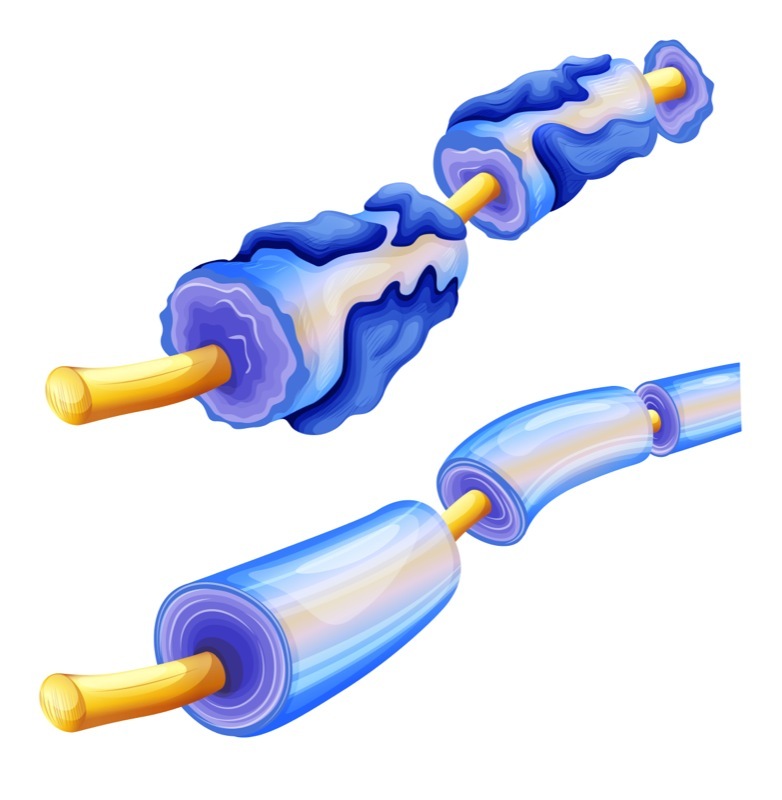Pathway and Its Proteins Found to Control Myelin Repair, Renewal

A pathway controlled by three proteins — Daam2, Nedd4, and VHL — was identified by researchers as a key regulator of myelin production during central nervous system development and regeneration after injury.
Myelin, the protective fatty layer that covers nerve fibers and helps to speed transmission of signals between nerve cells, is damaged and lost in multiple sclerosis (MS).
The study “The Daam2–VHL–Nedd4 axis governs developmental and regenerative oligodendrocyte differentiation” was published in the journal Genes & Development.
Oligodendrocytes are the cells responsible for myelin production in the central nervous system (CNS, the brain and spinal cord). When they are lost or fail to work properly, myelin regeneration due to MS or after an injury is known to be comprised.
Yet, the mechanisms underlying the regeneration of myelin are still largely unknown.
Researchers led by Hyun Kyoung Lee, PhD, an assistant professor of pediatrics at Baylor College of Medicine and the Jan and Dan Duncan Neurological Research Institute at Texas Children’s Hospital, investigated which genetic programs controlled myelin formation.
“Myelin is produced and assembled into sheaths by glial cells called oligodendrocytes (OL) via a series of steps regulated by signaling pathways,” Lee said in a press release.
“While several key features are common between developmental and regenerative myelination, it remains unclear how developmental programs are re-activated after an injury to initiate repair and regeneration in adulthood,” she added.
In prior work on gliomas (a brain tumor that affects glial cells), Lee’s team identified a protein, called dishevelled associated activator of morphogenesis 2 (Daam2), that inhibited oligodendrocyte development and repair. They found that Daam2 promoted the degradation of another protein, named hypoxia-associated von Hippel-Lindau (VHL), during the development of cancer (tumorigenesis).
“We found that in glial tumors (glioma), Daam2 and VHL displayed an antagonistic relationship — Daam2 promoted the degradation of VHL,” said Lee.
These findings prompted the researchers to ask whether this interaction was also important in myelin repair.
“We wondered whether Daam2-VHL displayed similar interactions in the context of myelin development and repair and this became our impetus for the current study,” Lee said.
The levels of VHL’s messenger RNA (the molecule serving as blueprint for the production of proteins) remained the same, meaning that Daam2 acted on the VHL protein, affecting its stability.
Damm2 cKO mice also showed an increase in the number of mature OLs. But this increase was reversed when researchers engineered the mice to lack both Daam2 and VHL during OL development. This suggests that Daam2 inhibits the maturation of OPCs into OLs by suppressing VHL.
Next, researchers investigated which additional factors played a role in Daam2-VHL’s antagonistic interaction.
They found that Daam2 mediated VHL’s degradation through the ubiquitin-proteosomal system (UPS), a program that flags proteins for degradation by tagging the proteins with ubiquitin marks.
An E3 ubiquitin ligase, called Nedd4, interacted with the Daam2-VHL complex with high affinity.
Similarly to Damm2 and VHL, Nedd4 was also found in oligodendrocyte lineage during CNS development.
Removing Nedd4 from OLs in a mouse model led to a dramatic drop in mature OLs, while precursor cells numbers were stable.
The myelin sheath in these mice was significantly thinner, and fewer myelatined nerve fibers were found in the spinal cord and in the corpus callosum, an area connecting the two sides of the brain. The loss of Nedd4 also led to lower VHL protein levels.
“We showed that Nedd4 is necessary and sufficient for developmental and regenerative myelination,” Lee said.
At the molecular level, the researchers also showed that Nedd4 stabilized the VHL protein, preventing its degradation.
The team then tested a mouse model of demyelination. Mice lacking Damm2 had a higher number of mature OLs at the lesion site, while mice lacking VHL or Nedd4 had fewer of these myelin-producing oligodendrocytes, the researchers reported. None of the models showed changes in OPC recruitment to the lesion sites.
“This was an exciting discovery because, although Nedd4 has been implicated in early neuronal development and cancers, this was the first demonstration of its role in glial development and regeneration,” Lee said.
In brain tissues from MS patients, Damm2 levels were increased in active lesions while Nedd4 and VHL were barely detectable, the researchers reported.
“Overall, these studies provide evidence that a signaling axis involving key UPS components contributes to oligodendrocyte development and repair and reveal a new role for Nedd4 in glial biology,” they wrote.
The team believes that the findings may also have implications in cancer research.
“Since VHL and Nedd4 are already known to play important roles in several cancers, we think down the road our findings could have broader implications that may well extend beyond myelin-associated neurological disorders or white matter injury to include malignancies,” Lee said.
This work was funded by the National Multiple Sclerosis Society, the Hilton Foundation, the National Institutes of Health and the Welch Foundation.






